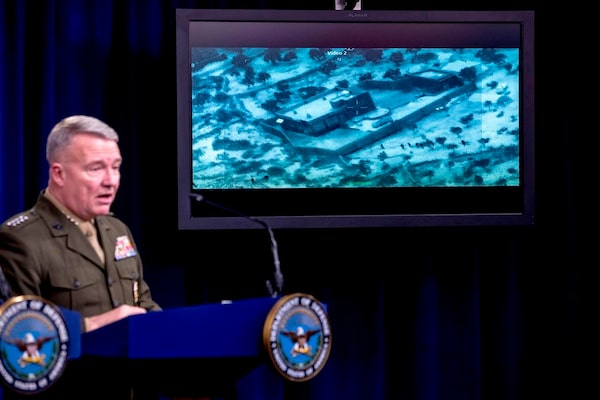
Video of the Abu Bakr al-Baghdadi raid is displayed as U.S. Central Command Commander Marine Gen. Kenneth McKenzie speaks on Oct. 30, 2019, at a joint press conference at the Pentagon.The Associated Press
The man who oversaw the raid on Islamic State leader Abu Bakr al-Baghdadi has provided the most detailed account yet of the operation and said the United States is on alert for possible “retribution attacks” by extremists.
General Kenneth (Frank) McKenzie, head of U.S. Central Command, said Mr. al-Baghdadi’s remains were buried at sea within 24 hours of his death inside an underground tunnel where he fled as special operations soldiers closed in on him.
The Pentagon on Wednesday released the first government photos and video clips of the nighttime operation, including one showing Delta Force commandos approaching the walls of the compound in which Mr. al-Baghdadi and others were found.
Another video showed air strikes on other militants who fired at helicopters carrying soldiers to the compound. The United States also bombed the compound after the soldiers completed the mission so that it would not stand as a shrine to Mr. al-Baghdadi.
“It looks pretty much like a parking lot with large potholes right now,” Gen. McKenzie said.
The attack was launched from an undisclosed location inside Syria for the one-hour helicopter ride to the compound, Gen. McKenzie said.
Two children died with Mr. al-Baghdadi when he detonated a bomb vest, Gen. McKenzie said, adding that this was one fewer than originally reported. He said the children appeared to be under the age of 12. Eleven other children were escorted from the site unharmed. Four women and two men who were wearing suicide vests and refused to surrender inside the compound were killed, Gen. McKenzie said.
He added that the military dog injured during the raid is a four-year veteran with U.S. Special Operations Command and had been on approximately 50 combat missions.
The dog was injured when it came in contact with exposed live electrical cables in the tunnel after Mr. al-Baghdadi detonated his vest, Gen. McKenzie said.
The dog, named Conan, will leave the Middle East to visit the White House next week, U.s. President Donald Trump tweeted.
Mr. Al-Baghdadi was identified by comparing his DNA to a sample collected in 2004 by U.S. forces in Iraq, where he had been detained.
The U.S. managed to collect “substantial” amounts of documentation and electronics during the raid, Gen. McKenzie said, but would not elaborate. Such efforts are a standard feature of raids against high-level extremist targets and can be useful in learning more about the group’s plans.
Although the raid was successful, Gen. McKenzie said it would be a mistake to conclude that the Islamic State has been defeated.
“It will take them some time to re-establish someone to lead the organization, and during that period of time their actions may be a little bit disjointed,” he said. “They will be dangerous. We suspect they will try some form of retribution attack, and we are postured and prepared for that.”
In outlining the operation, the general said Mr. al-Baghdadi had been at the compound in Syria’s northwest Idlib province for “a considerable period,” but he was not specific.
Gen. McKenzie said Mr. Trump was briefed on the raid plan on Friday, and the general made the decision to go ahead on Saturday morning.
Gen. McKenzie offered no new details about Mr. al-Baghdadi’s final moments.
“He crawled into a hole with two small children and blew himself up while his people stayed on the grounds,” he said when asked by a reporter about Mr. al-Baghdadi’s last moments and Mr. Trump’s description of the Islamic State leader as “whimpering and crying and screaming all the way” to his death.
Other senior Pentagon officials, including General Mark Milley, chairman of the Joint Chiefs of Staff, have said they could not confirm the President’s description.
Several times this month, Mr. Trump has said he is withdrawing from Syria and that the troops are “coming home.” But the U.S. military remains in the country, shifting positions and gearing up to execute Mr. Trump’s order to secure Syria’s oil fields – not for the Syrian government but for the Kurds. Mr. Trump also has said he wants to “keep” the oil, although it’s unclear what he means.
Earlier Wednesday, the acting homeland security secretary, Kevin McAleenan, told a congressional hearing that U.S. security agencies have been reminded of the potential for Mr. al-Baghdadi’s death to inspire his followers to launch an attack “in the immediate aftermath.”
Russell Travers, the acting director of the National Counterterrorism Center, told the same hearing that he does not believe Mr. al-Baghdadi’s death will have “much impact” on the organization.
“If there were significant attacks that were in the planning, that planning will continue. It won’t have that much effect,” Mr. Travers aid.
Within Syria and Iraq, he added, the Islamic State has at least 14,000 fighters.
“That’s an important number,” he said. “Because five, six years ago, when ISIS was at its low point, they were down under a thousand. To us, this tells us the insurgency has a lot of options.”
FBI Director Chris Wray said the biggest concern in the United States was the “virtual caliphate” that inspires Americans to pledge allegiance to the Islamic State and commit acts of violence in the group’s name even without travelling to Syria.
Representative Bennie Thompson, a Mississippi Democrat and chairman of the House Homeland Security Committee, said he worries that despite Mr. al-Baghdadi’s death, the conditions in Syria “are ripe for ISIS to reconstitute.”
Our Morning Update and Evening Update newsletters are written by Globe editors, giving you a concise summary of the day’s most important headlines. Sign up today.